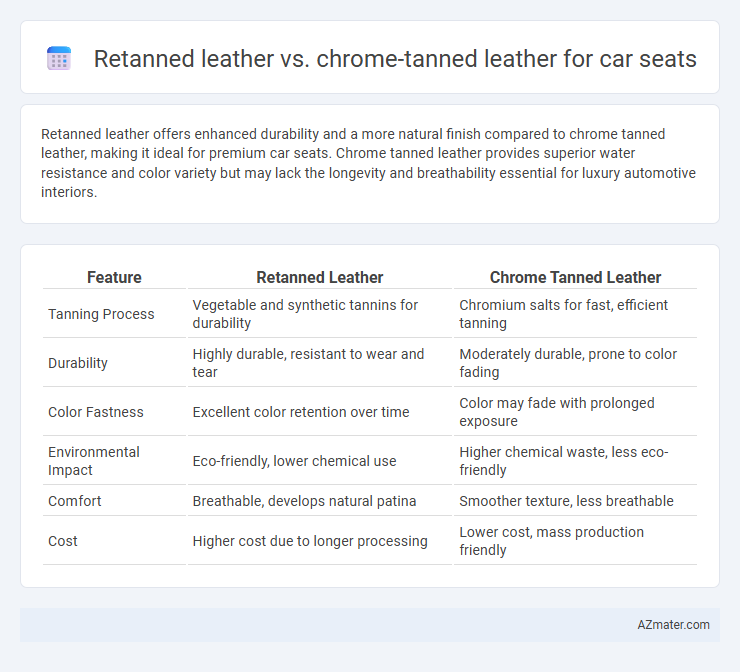Retanned leather offers enhanced durability and a more natural finish compared to chrome tanned leather, making it ideal for premium car seats. Chrome tanned leather provides superior water resistance and color variety but may lack the longevity and breathability essential for luxury automotive interiors.
Table of Comparison
| Feature | Retanned Leather | Chrome Tanned Leather |
|---|---|---|
| Tanning Process | Vegetable and synthetic tannins for durability | Chromium salts for fast, efficient tanning |
| Durability | Highly durable, resistant to wear and tear | Moderately durable, prone to color fading |
| Color Fastness | Excellent color retention over time | Color may fade with prolonged exposure |
| Environmental Impact | Eco-friendly, lower chemical use | Higher chemical waste, less eco-friendly |
| Comfort | Breathable, develops natural patina | Smoother texture, less breathable |
| Cost | Higher cost due to longer processing | Lower cost, mass production friendly |
Introduction to Car Seat Leather Types
Car seat leather types primarily include retanned leather and chrome tanned leather, each offering distinct characteristics suited for automotive interiors. Retanned leather undergoes a secondary tanning process enhancing durability, softness, and resistance to wear, making it ideal for luxurious and long-lasting car seats. Chrome tanned leather, treated with chromium salts, provides better water resistance, color retention, and flexibility, commonly preferred for modern vehicle upholstery with a focus on comfort and style.
What is Retanned Leather?
Retanned leather is leather that has undergone an additional tanning process after the initial chrome tanning to enhance its durability, softness, and colorfastness, making it ideal for high-use applications like car seats. This secondary treatment uses vegetable tannins or synthetic agents to improve the leather's fiber structure, resulting in a more pliable, robust material compared to standard chrome tanned leather. Retanned leather offers better resistance to wear, heat, and UV exposure, providing long-lasting comfort and aesthetic appeal in automotive interiors.
What is Chrome Tanned Leather?
Chrome tanned leather is treated using chromium salts, primarily chromium(III) sulfate, resulting in a more durable, flexible, and water-resistant material compared to traditional vegetable tanning methods. This type of leather offers superior color retention and a softer feel, making it ideal for car seats that need to withstand frequent use and varying temperatures. The chrome tanning process is quicker and more cost-effective, producing leather that resists creasing and fading over time in automotive interiors.
Durability Comparison: Retanned vs Chrome Tanned Leather
Retanned leather offers enhanced durability due to its additional tanning processes, which improve resistance to wear, moisture, and heat, making it ideal for car seats exposed to varying conditions. Chrome tanned leather, while soft and supple, tends to be less resistant to prolonged heat and UV exposure, potentially leading to faster fading and cracking over time. Choosing retanned leather for car seats results in longer-lasting material that maintains structural integrity and appearance under heavy use and environmental stress.
Comfort and Feel: Which Leather is Better?
Retanned leather offers a more natural and breathable texture, enhancing comfort during long drives by reducing heat buildup and moisture accumulation. Chrome tanned leather is typically softer and more pliable initially but can retain heat and feel less breathable, potentially causing discomfort in warmer climates. For car seats prioritizing comfort and feel, retanned leather provides a superior balance of durability and natural ventilation, making it the better choice for extended use.
Color and Finish Differences
Retanned leather offers a richer, more natural color palette with deeper, earth-toned hues, providing a matte to semi-gloss finish that enhances texture and breathability in car seats. Chrome tanned leather typically features brighter, more vibrant colors with a smooth, glossy finish that resists stains and moisture, offering a modern and uniform appearance. The colorfastness of chrome tanned leather ensures longevity in vibrant shades, while retanned leather provides a timeless, antique look that develops unique patinas over time.
Resistance to Wear and Environmental Factors
Retanned leather offers superior resistance to wear through its enhanced fiber structure, making it more durable for car seats under constant use. Chrome tanned leather provides excellent flexibility and water resistance but tends to be less robust against abrasion and UV exposure compared to retanned leather. Environmental factors like heat, sunlight, and moisture degrade chrome tanned leather faster, while retanned leather maintains its integrity longer due to additional tanning processes.
Maintenance and Cleaning Requirements
Retanned leather for car seats requires gentler maintenance with pH-balanced cleaners and minimal exposure to water to preserve its natural oils and prevent stiffness, while chrome tanned leather is more resistant to stains and easier to clean using mild detergents and regular wiping. Retanned leather often benefits from periodic conditioning to maintain suppleness, whereas chrome tanned leather can tolerate more frequent cleaning without significant damage. Choosing between the two depends on the desired balance of natural texture and ease of upkeep in automotive interiors.
Cost and Value Analysis
Retanned leather for car seats offers superior durability and a richer texture but comes at a higher initial cost compared to chrome tanned leather, which is more budget-friendly and widely used due to its faster processing time. Chrome tanned leather provides adequate resistance to wear and moisture but tends to degrade faster under UV exposure compared to retanned leather, which enhances long-term value through its improved aging properties. The cost-benefit analysis favors chrome tanned leather for economical short-term use, whereas retanned leather represents a premium investment with better lifespan and aesthetic retention in automotive interiors.
Which Leather is Best for Car Seat Upholstery?
Retanned leather offers superior durability and a more natural, breathable texture ideal for car seat upholstery, enhancing comfort and aging gracefully over time. Chrome tanned leather is more flexible and resistant to water and stains, making it easier to maintain but potentially less breathable and prone to faster wear in high-use environments. For car seat upholstery, retanned leather is often considered the best choice due to its balance of longevity, comfort, and premium appearance.

Infographic: Retanned leather vs Chrome tanned leather for Car seat
 azmater.com
azmater.com